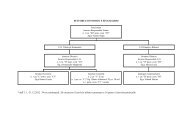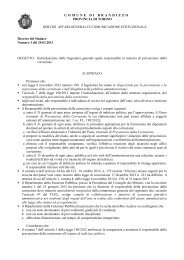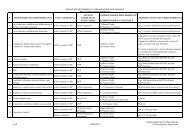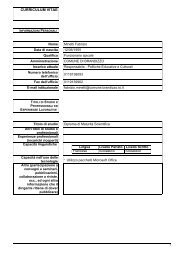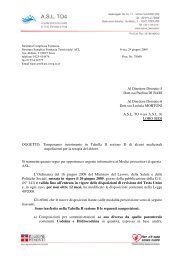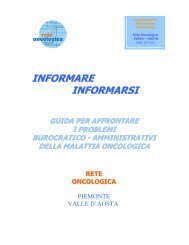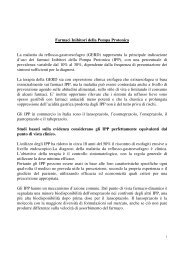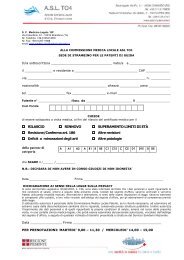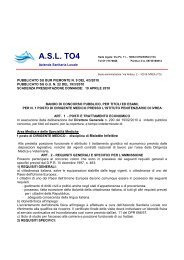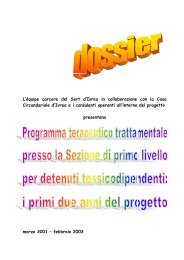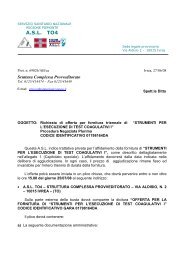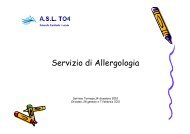Articolo sulla casistica delle non idoneità allo sport agonistico in ...
Articolo sulla casistica delle non idoneità allo sport agonistico in ...
Articolo sulla casistica delle non idoneità allo sport agonistico in ...
Create successful ePaper yourself
Turn your PDF publications into a flip-book with our unique Google optimized e-Paper software.
GALLOZZI BODY EQUILIBRIUM AND CONNECTIVE TISSUE<br />
The new anatomy techniques have enabled us<br />
to focus our reseaarch on anatomical details that<br />
have not been possible up to now. 14, 15 This has<br />
permitted more accurate observation and <strong>in</strong>vestigation<br />
of parts of the anatomy, lay<strong>in</strong>g bare connections<br />
as yet unknown or considered to be of<br />
little importance. 6 The <strong>in</strong>novative processes of<br />
conservation of the tissues have also made it possible<br />
to obta<strong>in</strong> images of the anatomical structure<br />
while preserv<strong>in</strong>g its natural appearance. In this<br />
way it has been possible to achieve a new view<br />
of the fascia. This follows a cont<strong>in</strong>uous route and<br />
envelopes all somatic and visceral structures,<br />
<strong>in</strong>clud<strong>in</strong>g the men<strong>in</strong>ges. In a certa<strong>in</strong> sense we<br />
can say that the fascia is the l<strong>in</strong><strong>in</strong>g material that not<br />
only envelopes all the structures of our body but<br />
also connects all the parts with one another, offer<strong>in</strong>g<br />
them support and determ<strong>in</strong><strong>in</strong>g their shape.<br />
In addition to the support and movement participation<br />
functions the fascia also covers biomechanical<br />
and biochemical functions. 16 The fascia<br />
organises and separates, assures the protection<br />
and <strong>in</strong>dependence of each muscle and viscera<br />
and, <strong>in</strong> so do<strong>in</strong>g, unites them <strong>in</strong> functional units<br />
establish<strong>in</strong>g the spatial relations between them<br />
and <strong>in</strong> this way form<strong>in</strong>g a k<strong>in</strong>d of seamless net-<br />
work of communication.<br />
2, 6, 17<br />
F<strong>in</strong>ally, it acts by modulat<strong>in</strong>g the action of<br />
nerves and lymphatic vessels, metabolic<br />
exchange, the nutritional function. The range of<br />
possibilities is astonish<strong>in</strong>g.<br />
Innervation of the fascia<br />
The fascia conta<strong>in</strong>s proprioceptive type receptors.<br />
Pac<strong>in</strong>ian and pac<strong>in</strong>iform corpuscles respond to<br />
rapid changes <strong>in</strong> pressure and vibrations; the<br />
Ruff<strong>in</strong>i organs respond to long-term changes <strong>in</strong><br />
pressure and lateral stretch<strong>in</strong>g (application of<br />
tangential forces). Their effect is not just local<br />
but general too because they <strong>in</strong>hibit the activity<br />
of the sympathetic nerve. Stimulation of the <strong>in</strong>terstitial<br />
mechanoceptors (see below) and of the<br />
Ruff<strong>in</strong>i and <strong>in</strong> part of the Golgi organs, by provok<strong>in</strong>g<br />
an <strong>in</strong>crease <strong>in</strong> vagal activity, can lead not<br />
only to local changes <strong>in</strong> the dynamics of fluids<br />
and the tissue metabolism, but also to a relaxation<br />
of muscle tone. Stimulation also acts at central level<br />
with less emotive reactivity and feel<strong>in</strong>g of relaxation.<br />
These two groups of receptors are fairly widely<br />
spread (fascia, tendons, ligaments, aponeurosis<br />
and jo<strong>in</strong>t capsules). Other types of receptors<br />
mici f<strong>in</strong>o ad ora <strong>non</strong> raggiungibili 14, 15. Ciò ha<br />
permesso una osservazione e una <strong>in</strong>vestigazione<br />
più precisa degli elementi anatomici scoprendo connessioni<br />
f<strong>in</strong>o ad ora sconosciute o considerate f<strong>in</strong>o<br />
ad ora di poca importanza 6. Gli <strong>in</strong>novativi processi<br />
di conservazione dei tessuti hanno, <strong>in</strong>oltre,<br />
permesso di ottenere immag<strong>in</strong>i della struttura anatomica<br />
conservandone il suo aspetto naturale. In<br />
questo modo è stato possibile realizzare una nuova<br />
visione della fascia. Questa ha un percorso cont<strong>in</strong>uo<br />
avvolgendo tutte le strutture somatiche e viscerali<br />
<strong>in</strong>cludendo le men<strong>in</strong>gi. In un certo modo possiamo<br />
dire che la fascia è il materiale di rivestimento<br />
che <strong>non</strong> solo avvolge tutte le strutture del nostro corpo,<br />
ma anche collega tra loro tutte le parti, offrendogli<br />
il sostegno e determ<strong>in</strong>andone la forma. Oltre<br />
alle funzioni di sostegno e partecipazione al movimento<br />
la fascia copre anche funzioni biomeccaniche<br />
e biochimiche 16. La fascia organizza e separa,<br />
assicura la protezione e l’autonomia di ogni muscolo<br />
e viscere ma, nel contempo, li riunisce <strong>in</strong> unità<br />
funzionali stabilendo le relazioni spaziali tra di<br />
loro e formando <strong>in</strong> questo modo una specie di rete<br />
<strong>in</strong><strong>in</strong>terrotta di comunicazione<br />
2, 6, 17.<br />
Agisce, <strong>in</strong>f<strong>in</strong>e, modulando l’azione di nervi e vasi<br />
l<strong>in</strong>fatici, l’<strong>in</strong>terscambio metabolico, la funzione nutritiva.<br />
Il ventaglio di possibilità è sorprendente.<br />
L’<strong>in</strong>nervazione della fascia<br />
La fasca possiede al suo <strong>in</strong>terno recettori di tipo<br />
propriocettivo.<br />
I corpuscoli di Pac<strong>in</strong>i e i Pac<strong>in</strong>iformi rispondono<br />
a rapidi cambiamenti di pressione e alle vibrazioni;<br />
gli organi di Ruff<strong>in</strong>i rispondono a cambiamenti<br />
di pressione a lungo term<strong>in</strong>e e a stiramenti laterali<br />
(applicazione di forze tangenziali). Il loro effetto<br />
<strong>non</strong> è soltanto locale ma anche generale perché<br />
<strong>in</strong>ibiscono l’attività del simpatico. La stimolazione<br />
dei meccanocettori <strong>in</strong>terstiziali (vedi oltre) e di<br />
Ruff<strong>in</strong>i, ed <strong>in</strong> parte degli organi del Golgi, provocando<br />
un aumento dell’attività vagale, può condurre<br />
<strong>non</strong> solo a cambiamenti locali <strong>delle</strong> d<strong>in</strong>amiche<br />
dei fluidi e del metabolismo dei tessuti, ma anche<br />
a un rilassamento del tono muscolare. La stimolazione<br />
agisce anche a livello centrale con m<strong>in</strong>ore<br />
reattività emotiva e sensazione di rilassatezza.<br />
Questi due gruppi di recettori hanno una diffusione<br />
abbastanza ampia (fascia, tend<strong>in</strong>i, legamenti,<br />
aponeurosi e capsule articolari). Altri tipi di recettori<br />
(di tipo III e IV) detti <strong>in</strong>terstiziali, sono molto<br />
diffusi. Basti pensare che a livello del nervo tibiale<br />
anteriore ben un quarto <strong>delle</strong> fibre provengono da<br />
questi recettori. Rispondono a cambiamenti di pressione<br />
e tensione, trasmettono il dolore e sono fon-<br />
398 MEDICINA DELLO SPORT Dicembre 2009



